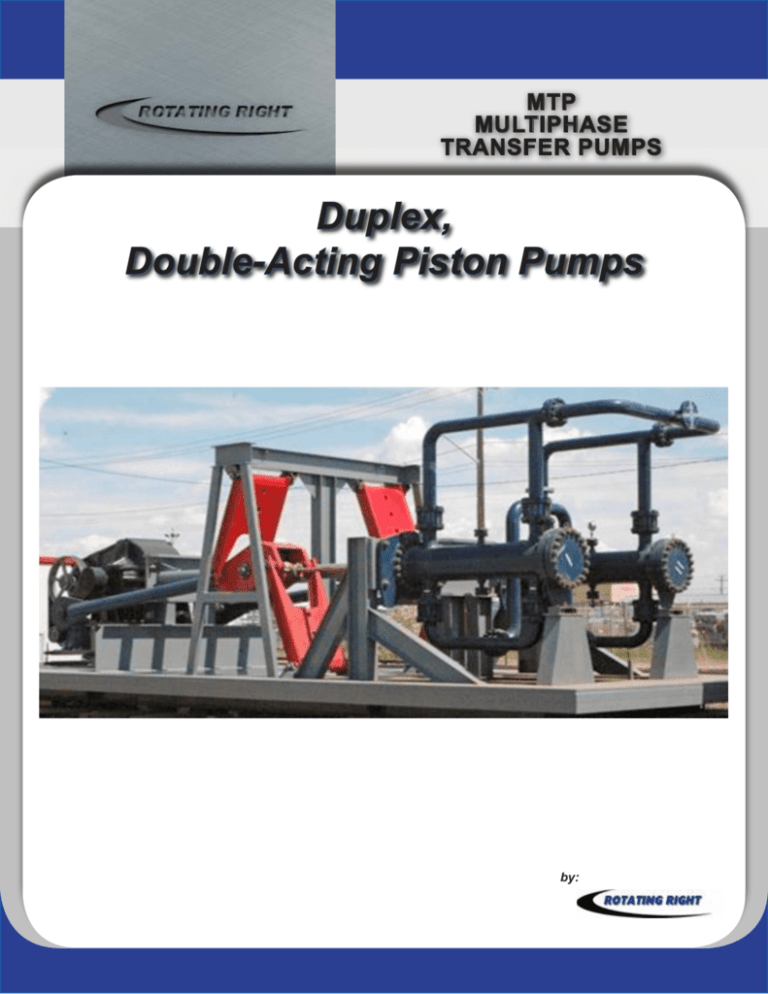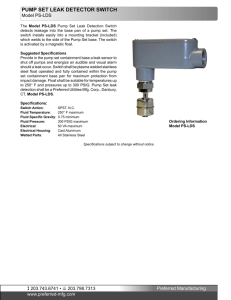Duplex, Double-Acting Piston Pumps
advertisement

MTP multiphase transfer pumps Duplex, Double-Acting Piston Pumps by: Multiphase Pump Applications Increase Oil Production • • • • • Reduce Back Pressure on Formation to Increase Inflow into the Wellbore Rod Pumping Systems PC Pumping Systems Flowing Wells Submersible Pumps New Pool Tie-Ins • New Battery vs. Multiphase Pumping (MP) • Lower Cost for MP • MP Environmentally Friendly (No Flaring) • MP Moves Water To a Central Facility, Reducing The Number of Water Disposal Wells • Water Injection Issue Battery Consolidation • • • • • • Reduces Operating Costs MP Environmentally Friendly May Be Economical When Facility Upgrades Required Tank or Vessel Replacement Disposal Well Problems Pump or Compressor Repairs Required Multiphase Pumping vs. Line Looping • • • • MP May Be Less Expensive Than Line Looping Line Looping Does Not Consume Power MP May Reduce Pressure Lower Than Line Looping MP May Be Moved Eliminate Hydrates • Reducing Flowline Pressures May Lower Operating Costs, Including Costs Associated with Hydrate Formation Multiphase Transfer Pumps Rotating Right’s multiphase transfer pump (MTP) is a duplex, double-acting piston pump that is capable of handling up to 250,000 BOEPD of water, oil and gas mixtures. Our pump can handle up to 99.5% Gas Volume Fraction (GVF) continuously, and up to 100% gas on an intermittent basis. This pump can be designed up to 700 PSI differential pressure and up to 1,440 PSIG working pressure. With our design, the pump operates at a very low speed (less than 15 RPM) and can handle solids, high temperatures and high amounts of H2S. Our housing, pistons and liners can be made from a variety of materials to suit your pumping application. Our shaft sealing is a very simple design that is used on thousands of critical wells throughout the world. Rotating Right’s employees have over 25 years of experience in the design, manufacturing and installation of multiphase piston pumps and systems. We have the engineering, design and drafting experience and capability to build complete turnkey housed and piped, multiphase pump packages. Multiphase Transfer Pump History: • • • • • • • 1987 – Original concept developed 1988 – Prototype tested in Steelman, Saskatchewan 1989 – MTP built for Rainbow Lake 1991 – Patent granted for MTP pump design 2005 – Duplex pump design developed 2008 – Rotating Right obtains licence from IOR 2008 – First Duplex MTP built and tested MTP Working Principle The Rotating Right MultiPhase Transfer Pump (MTP) is designed for high gas volume fraction (GVF) wells, by trapping liquid in the pump at the end of the stroke (see Figure 1) to reduce the gas expansion and maintain a seal between the piston and liner. During the stroke, the fluid enters the pump through a suction valve (see Figure 2) in one pumping chamber and is discharged through the discharge valve in the opposite pumping chamber. Gas is discharged from the pump prior to the liquid. At the end of the stroke (see figure 1) the gas has been displaced from the pump leaving liquid in the pump chamber. With very little gas remaining in the pump, high volumetric efficiencies can be maintained, even at high GVFs. The Rotating Right MultiPhase Transfer Pump (MTP) is especially suited for high temperatures and high gas fraction applications. Figure 1. END OF STROKE Figure 2. MIDDLE OF STROKE Rotating Right MTP Sizing Example 50 M3/DAY 50 M3/DAY 15,000 M3/DAY 50 PSIG 350 PSIG Inlet Pressure (PSIG) Power Required for 100% Liquid (HP) Oil Rate: Water Rate: Gas Rate: Desired Inlet Pressure: Discharge Pressure: Inlet Flow Rate (M3/DAY) In the Graph above, the curved line is the production curve for a particular pump; in this case a pump with a 9” OD pistion, pumping a given O / W / G fluid conbmbination at a given pressure and temperature. We wish to determine the equivalent inlet flow rate, the pump speed and the power required to pump the fluid of 100% liquid, at the same temperature. Selection Procedure: 1) From the right vertical axis select your inlet pressure, trace a horizontal line to where it intersects the curved line. 2) From that intersection, trace a vertical line down to the horizontal axis. 3) Where the vertical line intersects the horizontal axis indicates the equivalent inlet flow rate. 4) Follow that vertical line back up to where it intersects any of the differential pressure lines (the diagonal lines rising from the bottom left corner.) 5) From that intersection point, trace a horizontal line to the left axis. 6) Where that horizontal line intersects the left axis indicates the power required. So, in the example above, given a suction pressure of 50 PSI, and a differential pressure of 300 PSI, the pump will require 140 HP to pump an equivalent flow rate of 3600 M3/DAY of 100% liquid fluid. Rotating Right Certifications ASME B31.1 and B31.3 Certified ISO 9001-2000 Certified Rotating Right is proud to be ISO 9001-2000 Certified, this Quality Management System ensures you will receive top quality service, exceptional workmanship and all required documentation for every pump or system we offer. We have procedures in place from your initial contact with us through to after sales service that is second to none. We pride ourselves on providing quotations and documentation in a timely and professional manner with the technical expertise our customers have come to rely on. Rotating Right Technical Expertise Combined Gas Laws (Boyle’s, Charle’s and Gay-Lussac’s) P1V1/T1 = P2V2/T2, Where: T1 = Standard Temperature (460 Rankine When Using F Scale and 273 Kelvin When Using C Scale) T2 = Actual Gas Temperature = (460 + F) Rankine or (273 + C) Kelvin P1 = Atmospheric Pressure 14.7 PSI or 101 kPa P2 = Inlet Gauge Pressure + Atmospheric (PSI or kPa) V1 = Gas Volume at Standard Pressure and Temperature (14.7 PSI and 460 Rankine or 101 kPa and 273 Kelvin) V2 = Gas Volume at P2 Pressure and T2 Temperature To Determine V2: Insert Client-Supplied Information to Solve Equation Metric: V2 = 10000 X 101 X 273 = 790.6 M3/DAY (1050 + 101) X (273 + 30) (?) US: V2 = 356617 X 14.7 X 460 = 26816 Actual Cubic Feet/Day (150 + 14.7) X (460 + 86) Add All Components Together to Arrive at the Total Volume the Pump Must Handle. Technical Formulas • M3/DAY = GPM x 0.18345 • BPD = M3/DAY x 6.2897 • KPA = PSI / 0.145 • PSI = Feet of Head x 2.307 x SG • HP = KW x 0.746 • M3 = FT3 x 35.315 • INCHES = MM x 25.4 • BAR = PSI x 14.5 • USGPM = ��������������������������������������� FT3/DAY x 0.0052 • USGPM = BPD 0.0292 USER ADVANTAGES • Simplex and Duplex Pump Designs • Variety of Materials of Construction • 99.5% GVF Continuous up to 100% • Sizes to 250,000 BOEPD • Differential Pressures to 700 PSIG • Slow Speeds • Up to 1,440 PSIG Working Pressure • High Temperature Capability LEFT VIEW RIGHT VIEW Turnkey Solutions Rotating Right employees have over 25 years of experience in the design, manufacturing and installation of multiphase transfer pumps. We have the engineering, design and drafting experience and capability to build complete turnkey housed and piped multiphase pump packages. Head Office: 6120 Davies Road Edmonton, Alberta Canada T6E 4M9 Phone: (780) 485-2010 • Toll Free: (866) 707-7867 Fax: (780) 485-1938 • Calgary • Drayton Valley • Lethbridge www.rotatingright.com






